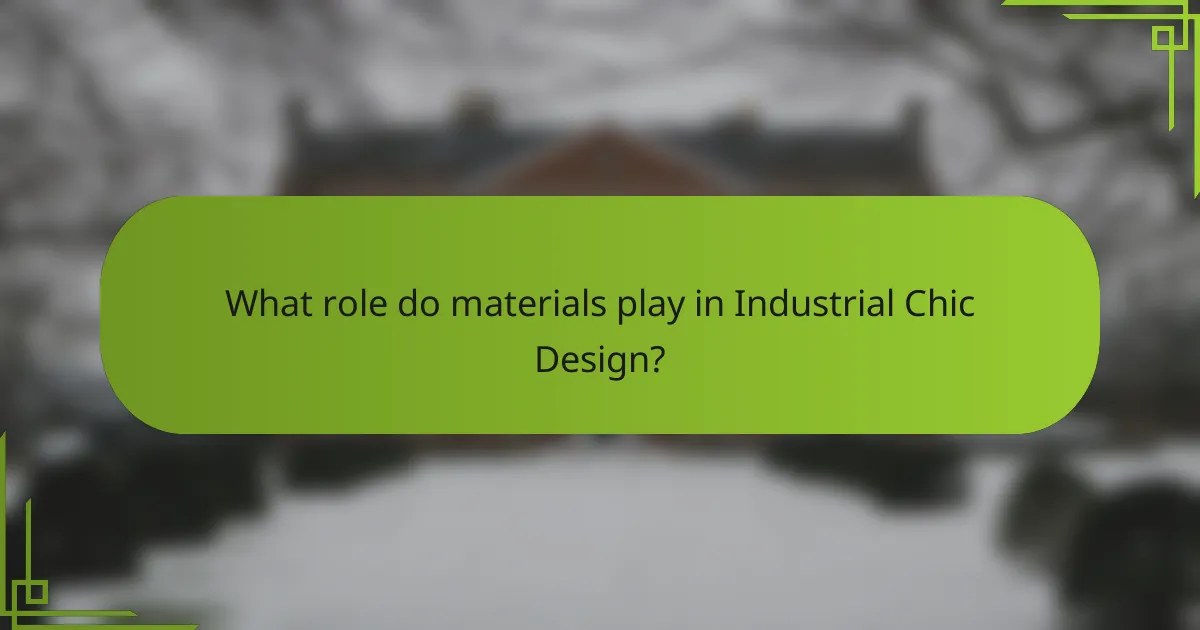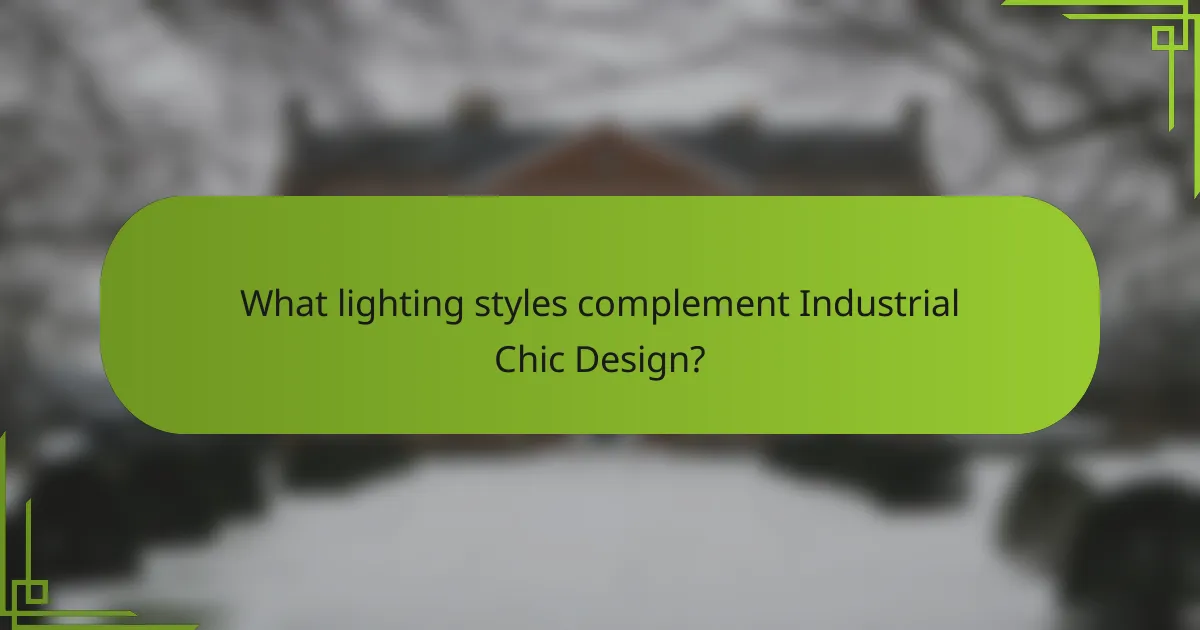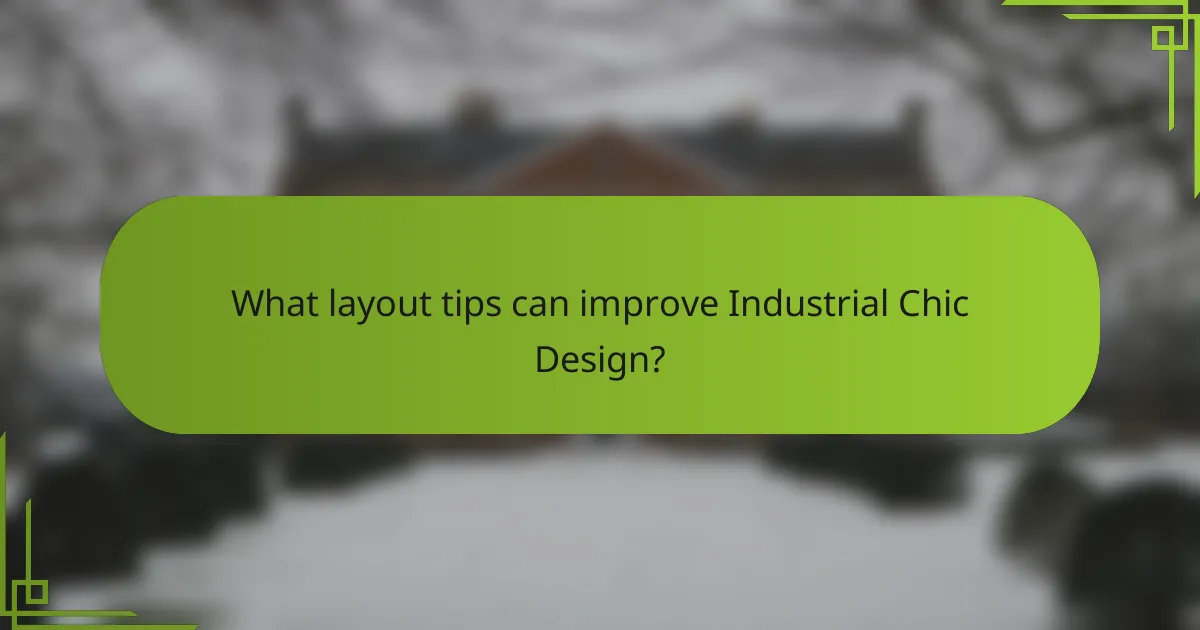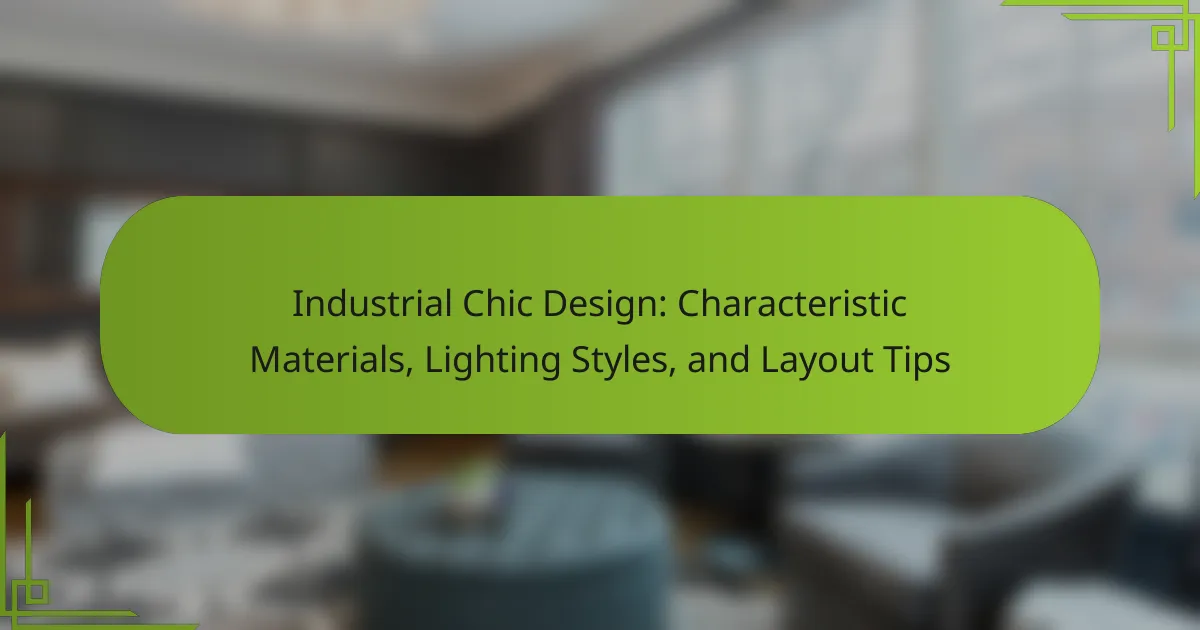
What is Industrial Chic Design?
Industrial Chic Design is a style that combines industrial elements with modern aesthetics. It features raw materials like exposed brick, metal, and wood. This design emphasizes open spaces and minimalism. Furniture often includes vintage or repurposed items. Lighting typically uses Edison bulbs or metal fixtures. The look aims for a casual yet sophisticated vibe. This style emerged in the late 20th century, influenced by converted warehouses and factories. Its popularity reflects a desire for authenticity and character in interior spaces.
How did Industrial Chic Design originate?
Industrial Chic Design originated in the late 20th century. It emerged as a response to the revitalization of old factories and warehouses. Urban areas began transforming these spaces into residential and commercial properties. The design style embraces raw materials like exposed brick, steel, and wood. It highlights functional elements, often leaving mechanical systems visible. This aesthetic reflects an appreciation for industrial history and craftsmanship. The trend gained momentum in cities like New York and London during the 1980s and 1990s. Today, it remains popular in modern interior design.
What historical influences shaped Industrial Chic Design?
Industrial Chic Design is influenced by the industrial revolution and urbanization. The industrial revolution in the late 18th century introduced factories and warehouses. These structures featured exposed materials like brick, steel, and concrete. Urbanization in the 19th and 20th centuries led to the repurposing of industrial spaces. Abandoned factories became trendy lofts and studios. This trend emphasized raw aesthetics and functional design. Additionally, the minimalist movement in the mid-20th century reinforced simplicity in design. Collectively, these historical influences shaped the unique characteristics of Industrial Chic Design.
How has Industrial Chic Design evolved over time?
Industrial Chic Design has evolved significantly since its inception in the late 20th century. Initially, it emerged as a response to urban decay and the repurposing of industrial spaces. The design style features raw materials like exposed brick, metal, and wood, emphasizing functionality. Over time, it has integrated modern aesthetics, incorporating sleek lines and minimalism. The trend gained popularity in the early 2000s, influenced by the rise of loft living. Today, it blends with other styles, such as modern and rustic, creating hybrid designs. This evolution reflects changing consumer preferences for sustainability and authenticity in home decor.
What are the key characteristics of Industrial Chic Design?
Industrial Chic Design features a blend of raw materials and modern aesthetics. Key characteristics include exposed brick walls that showcase the building’s history. Metal elements, such as steel beams and pipes, add an industrial feel. Open floor plans promote spaciousness and versatility. Vintage furnishings contribute to a curated, eclectic look. Minimalist decor emphasizes functionality over ornamentation. Neutral color palettes, often with pops of bold color, create a balanced environment. Large windows allow natural light to enhance the space.
What materials are commonly used in Industrial Chic Design?
Common materials used in Industrial Chic Design include metal, wood, and concrete. Metal often appears in furniture and fixtures, providing a raw and durable aesthetic. Wood adds warmth and contrast, typically used in flooring and tabletops. Concrete is frequently utilized in walls and countertops, contributing to an urban feel. Additionally, glass is used in lighting and partitions to enhance openness. These materials reflect the industrial origins of the style, emphasizing functionality and simplicity. The combination of these elements creates a cohesive look that defines Industrial Chic spaces.
How do color palettes influence Industrial Chic spaces?
Color palettes significantly influence Industrial Chic spaces by shaping their overall aesthetic and mood. The use of neutral tones, like grays and browns, creates a raw, unfinished look typical of industrial design. These colors highlight the materials, such as exposed brick and metal, enhancing the space’s authenticity. Bold accent colors can be introduced to create focal points and add personality. For instance, deep blues or vibrant reds can contrast with muted backgrounds, drawing attention to specific areas. This strategic use of color can also affect the perceived size and warmth of a space. Lighter palettes may make a room feel more open and airy, while darker shades can create intimacy. Ultimately, the chosen color palette helps define the character of the space and influences how occupants feel within it.

What role do materials play in Industrial Chic Design?
Materials are fundamental in Industrial Chic Design. They create the aesthetic and atmosphere of the space. Common materials include exposed brick, metal, and reclaimed wood. These materials convey a sense of authenticity and ruggedness. The use of raw and unfinished textures enhances the industrial feel. Metal elements often serve both functional and decorative purposes. For example, steel beams can be structural while also being visually striking. Additionally, the combination of different materials adds depth and interest to the design. This approach reflects the history of industrial spaces, repurposing elements to create modern living environments.
What are the most popular materials in Industrial Chic Design?
The most popular materials in Industrial Chic Design include metal, wood, and concrete. Metal is often used for furniture, fixtures, and accents, providing a raw and utilitarian aesthetic. Wood adds warmth and texture, commonly seen in reclaimed forms or distressed finishes. Concrete is frequently utilized for flooring, countertops, and walls, offering a modern and industrial feel. These materials collectively create a blend of ruggedness and sophistication. Their popularity stems from their ability to convey an urban, minimalist vibe while remaining functional and durable.
How do metals contribute to the Industrial Chic aesthetic?
Metals significantly contribute to the Industrial Chic aesthetic by adding a raw, unfinished look. This aesthetic embraces materials like steel, iron, and aluminum. These metals evoke a sense of authenticity and industrial history. They often feature in furniture, fixtures, and architectural elements. The use of exposed metal beams and piping enhances the industrial feel. Metal surfaces can be left in their natural state or treated for a polished appearance. This versatility allows for various design interpretations. Additionally, metals are durable and functional, aligning with the practical aspects of industrial design. Overall, metals play a crucial role in defining the Industrial Chic aesthetic through their unique textures and forms.
What is the significance of wood in Industrial Chic interiors?
Wood is significant in Industrial Chic interiors due to its ability to add warmth and texture. This style often features raw, unfinished surfaces that contrast with metal and concrete elements. Wood introduces an organic feel, softening the overall aesthetic. It also reflects the historical use of timber in industrial settings, connecting the design to its roots. Furthermore, wood can be used in various forms, such as reclaimed beams or furniture, enhancing sustainability. The use of wood contributes to a balanced environment by combining rustic charm with modern industrial elements.
How can textures enhance Industrial Chic Design?
Textures enhance Industrial Chic Design by adding depth and visual interest. They create a tactile experience that complements the raw materials typically used in this style. For example, exposed brick walls can contrast with smooth metal surfaces. This interplay of textures fosters a dynamic atmosphere. Additionally, incorporating reclaimed wood introduces warmth to the otherwise cool industrial elements. Textured fabrics in furniture soften the look, making spaces more inviting. The use of varying textures also helps define different zones within an open layout. Overall, textures play a crucial role in balancing the aesthetic of Industrial Chic Design.
What textures are typically found in Industrial Chic spaces?
Industrial Chic spaces typically feature a mix of raw and refined textures. Common textures include exposed brick, polished concrete, and weathered wood. Metal elements, such as steel beams and iron fixtures, are also prevalent. These textures create a balance between ruggedness and sophistication. The combination of these materials enhances the industrial aesthetic. For example, exposed ductwork adds an architectural element. Additionally, textiles like leather and canvas can soften the overall look. This blend of textures contributes to the unique character of Industrial Chic design.
How can contrasting textures create visual interest?
Contrasting textures create visual interest by adding depth and complexity to a design. Different textures can evoke various emotions and responses from viewers. For example, a rough surface juxtaposed with a smooth one can enhance tactile appeal. This interplay draws the eye and encourages exploration of the space. In industrial chic design, combining materials like metal and wood exemplifies this principle. The stark difference between the coldness of metal and the warmth of wood captivates attention. Studies show that varied textures can increase engagement in interior spaces. This principle is widely applied in design to create dynamic environments.

What lighting styles complement Industrial Chic Design?
Exposed bulb lighting styles complement Industrial Chic Design. This style emphasizes raw materials and minimalism. Pendant lights with Edison bulbs enhance the industrial aesthetic. They provide a warm, inviting glow. Track lighting can also be effective. It highlights architectural features and artwork. Industrial sconces add character to walls. They often feature metal and vintage finishes. Floor lamps with a metallic finish can enhance the design. These elements create a cohesive industrial look.
What types of lighting are most effective in Industrial Chic interiors?
The most effective types of lighting in Industrial Chic interiors include pendant lights, exposed bulbs, and track lighting. Pendant lights provide focused illumination and enhance the industrial aesthetic. Exposed bulbs create a raw, unfinished look, which is characteristic of this design style. Track lighting allows for adjustable illumination and can highlight specific areas or features in the space. These lighting types complement the overall industrial theme by utilizing materials like metal and glass. They also contribute to the ambiance by creating a warm, inviting atmosphere in open spaces.
How do pendant lights fit into the Industrial Chic aesthetic?
Pendant lights are integral to the Industrial Chic aesthetic. They embody the raw, utilitarian charm characteristic of this design style. Often made from materials like metal and glass, pendant lights enhance the industrial feel. Their designs frequently feature exposed bulbs and simple lines. This aligns with the minimalist approach of Industrial Chic. The use of pendant lights can create focal points in open spaces. They also provide functional lighting while adding visual interest. Overall, pendant lights contribute significantly to the ambiance and style of Industrial Chic interiors.
What role does natural light play in Industrial Chic spaces?
Natural light is essential in Industrial Chic spaces. It enhances the aesthetic appeal of raw materials. Large windows are common in this design style. They allow abundant sunlight to illuminate the interiors. Natural light creates a warm and inviting atmosphere. It highlights the textures of concrete, metal, and wood. Studies show that natural light improves mood and productivity. This is particularly beneficial in workspaces designed with an Industrial Chic theme.
How can lighting enhance the mood in Industrial Chic Design?
Lighting can significantly enhance the mood in Industrial Chic Design. It creates an atmosphere that reflects the raw and edgy aesthetic of the style. Warm lighting can soften the hard edges typically found in industrial spaces, promoting a cozy environment. Conversely, cooler lighting can accentuate the industrial elements, emphasizing the space’s raw materials like metal and concrete. Pendant lights and exposed bulbs are commonly used to maintain the industrial feel while providing functional illumination. Layering different light sources, such as ambient and task lighting, can add depth and dimension to the space. The choice of fixtures can also contribute to the overall theme, with vintage or industrial-style lamps reinforcing the design ethos. Effective lighting design can transform a stark industrial space into a welcoming and stylish environment.
What are the best practices for layering lighting in these spaces?
Layering lighting in industrial chic spaces involves combining ambient, task, and accent lighting. Ambient lighting provides overall illumination. This can be achieved through ceiling fixtures or large pendant lights. Task lighting focuses on specific areas for activities like reading or working. Examples include desk lamps and under-cabinet lighting. Accent lighting highlights architectural features or artwork. Use wall sconces or track lighting for this purpose.
When layering, consider the height and placement of each light source. Varying heights creates visual interest. Dimmers can adjust brightness levels for different moods. Using warm light bulbs enhances the industrial aesthetic. Incorporating metallic finishes aligns with the design style. This approach ensures functionality while maintaining the unique character of industrial chic spaces.
How can lighting fixtures serve as statement pieces?
Lighting fixtures can serve as statement pieces by acting as focal points in a room. They can enhance the overall aesthetic of a space through unique designs and styles. Distinctive shapes, materials, and colors can draw attention and create visual interest. For example, oversized pendant lights can dominate a dining area, while sculptural floor lamps can add character to a living room. Additionally, lighting fixtures can reflect personal style and taste, making them integral to the design narrative. High-quality materials like brass or glass can elevate the sophistication of a space. Moreover, statement lighting can complement other design elements, reinforcing a cohesive look. In industrial chic design, fixtures often combine raw materials with sleek finishes, enhancing the theme’s character.

What layout tips can improve Industrial Chic Design?
To improve Industrial Chic Design, incorporate open layouts that enhance spatial flow. Open spaces allow for natural light and create an airy atmosphere. Use furniture with clean lines to maintain a minimalist aesthetic. Incorporate industrial materials like metal and reclaimed wood for authenticity. Arrange furniture to encourage conversation and interaction. Utilize area rugs to define spaces within larger areas. Keep color palettes neutral to emphasize the industrial elements. Add greenery to soften the hard edges of industrial design. These tips enhance functionality while staying true to the Industrial Chic style.
How should furniture be arranged in an Industrial Chic space?
Furniture in an Industrial Chic space should be arranged to enhance openness and functionality. Use large, sturdy pieces that complement the raw materials typical of this style, such as metal and reclaimed wood. Position sofas and chairs to create conversational areas without obstructing pathways. Incorporate multifunctional furniture to maximize space efficiency. Utilize industrial elements like metal shelves and exposed lighting to accentuate the aesthetic. Maintain a balance between comfort and the rugged, utilitarian feel. Group furniture in clusters to foster an inviting atmosphere. Ensure that the arrangement allows for natural light to flow through the space, highlighting architectural features.
What are the benefits of open floor plans in Industrial Chic Design?
Open floor plans in Industrial Chic Design enhance spatial flow and promote social interaction. They eliminate barriers, creating a cohesive environment. This layout allows natural light to permeate the space, improving ambiance. The open design also facilitates flexible furniture arrangements. It accommodates various activities, from work to leisure. Additionally, it emphasizes the raw, industrial aesthetic through exposed materials. Studies show open layouts can increase perceived space by up to 25%. This design choice aligns with contemporary lifestyle preferences for openness and connectivity.
How can zoning be effectively achieved in Industrial Chic interiors?
Zoning in Industrial Chic interiors can be effectively achieved through the use of furniture arrangement and distinct materials. Dividing spaces with furniture, such as sofas or shelves, creates clear functional areas. Using rugs can visually separate different zones while maintaining an open layout. Incorporating varying lighting styles, like pendant lights for dining areas and floor lamps for reading nooks, enhances the separation of spaces. Industrial materials, such as metal and reclaimed wood, can also define areas; for instance, a metal partition can delineate an office space. This approach not only maintains the aesthetic but also provides functional clarity.
What are common mistakes to avoid in Industrial Chic Design?
Common mistakes to avoid in Industrial Chic Design include over-cluttering spaces. An industrial chic aesthetic thrives on minimalism and open layouts. Excessive decor can detract from the raw, functional appeal of the style. Another mistake is neglecting lighting. Proper lighting enhances the industrial elements and creates a warm atmosphere. Using only overhead fixtures can result in harsh shadows and an uninviting space. Additionally, failing to incorporate texture is a common error. Industrial chic relies on a mix of materials, like metal, wood, and concrete, for visual interest. Ignoring this can lead to a flat, uninspired design. Lastly, overlooking the importance of balance can disrupt the harmony of the space. An effective industrial chic design should balance rugged elements with softer touches to create a cohesive look.
How can over-cluttering affect the Industrial Chic aesthetic?
Over-cluttering can significantly detract from the Industrial Chic aesthetic. This design style emphasizes open spaces and minimalism. When clutter accumulates, it disrupts the clean lines and functional beauty that define Industrial Chic. The aesthetic relies on the balance between raw materials and airy environments. Excess items can obscure architectural features, such as exposed beams and brick walls. This can lead to a chaotic atmosphere that contradicts the intended industrial vibe. A study by the Journal of Environmental Psychology indicates that clutter can increase stress levels and reduce focus. Therefore, maintaining a clutter-free space is essential for preserving the integrity of the Industrial Chic aesthetic.
What should be considered when balancing functionality and style?
When balancing functionality and style, prioritize usability alongside aesthetic appeal. Functionality ensures that the design serves its intended purpose effectively. Style enhances the visual appeal and creates an inviting atmosphere. Consider materials that are both durable and visually striking, such as metal and reclaimed wood. Lighting should be practical while complementing the overall design theme. Space layout must facilitate movement and accessibility without compromising on style. Each element should harmonize to create a cohesive look that is both attractive and practical.
What practical tips can enhance your Industrial Chic Design?
Incorporate raw materials to enhance your Industrial Chic Design. Use exposed brick, concrete, and metal for an authentic look. Incorporate vintage furniture to add character and warmth. Use oversized light fixtures, such as pendant lights, to create a focal point. Select a neutral color palette with pops of bold colors for contrast. Incorporate open spaces to maintain an airy feel. Use industrial-style accessories, like gears or pipes, to reinforce the theme. Layer textures with soft textiles to balance the hardness of materials.
Industrial Chic Design is a style that merges industrial elements with modern aesthetics, characterized by raw materials such as exposed brick, metal, and wood, along with a focus on open spaces and minimalism. This article explores the origins of Industrial Chic Design, its historical influences, and key characteristics, including common materials and effective lighting styles. Additionally, it offers practical layout tips to enhance functionality while maintaining the style’s unique appeal. Readers will gain insights into the significance of textures, color palettes, and furniture arrangement in creating inviting Industrial Chic interiors.
